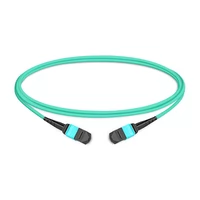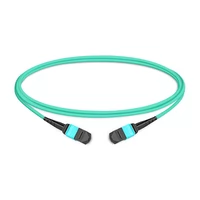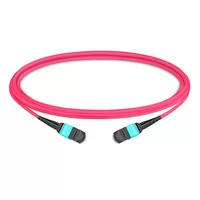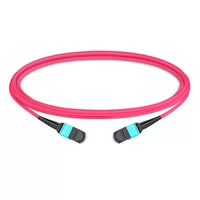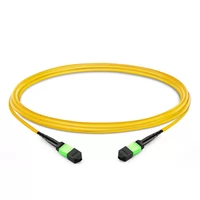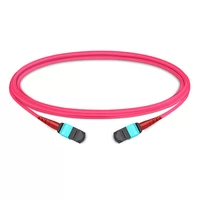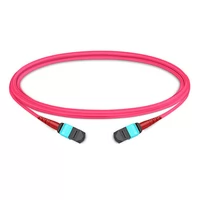Multi-fiber push-on connectors, or MTP® fiber connectors, are essential units in modern-day data centers and telecommunication networks. They enhance data connectivity and operational efficiency. As the need for high-speed data transmission continues to rise alongside network infrastructural complexity, MTP® connectors become increasingly essential because they incorporate several fiber strands into one highly efficient connector, thereby saving space and increasing information throughput.
Table of Contents
ToggleWhat is an MTP® Connector and How Does it Work?
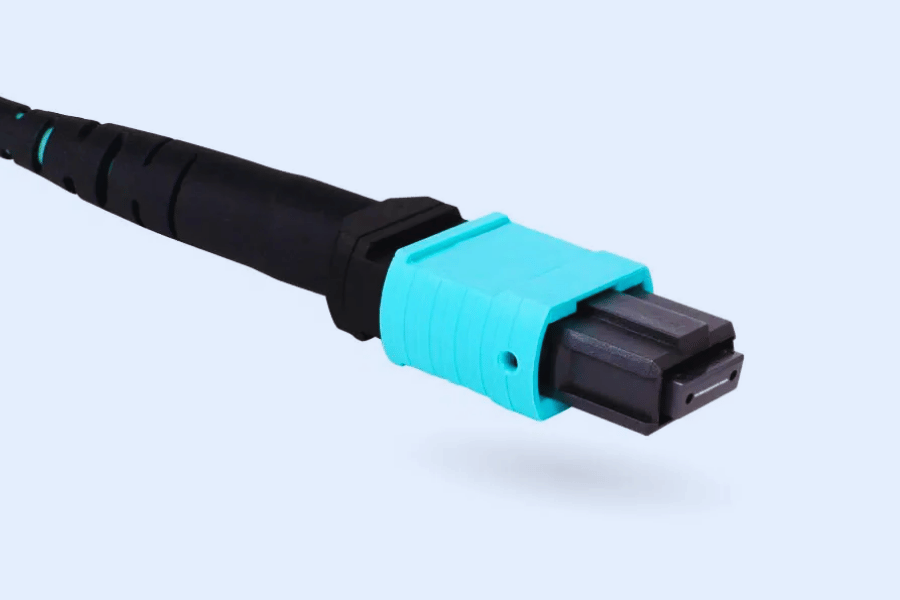
Understanding the Basics of Fiber Optic Connectors
Fiber-optic connectors are tools used in situations where connection or disconnection of optical fibers is needed. In fiber-optic communication, they serve the purpose of aligning and joining fibers to facilitate efficient transmission of light signals. MTP® (Multi-Fiber Push-On) connectors are designed to handle multiple fibers in one assembly thus providing high-density connectivity solutions. A precision ferrule, guide pins, and housing for protection against dust, which could affect alignment accuracy, make up these connector types. The establishment of faster, more reliable, and more efficient optical networks is made possible by MTP® connectors that simplify connecting process flows.
Introduction to Multi-Fiber Push-On Technologies
The reason why multi-fiber push-on (MTP®) technology is so great is that it can cram lots of fiber optic connections into small spaces. This involves using an MT (mechanical transfer) ferrule which has many fibers—usually 12 or 24—in one connector, and this beats standard connectors by a mile when it comes to connection density. To keep signal integrity intact, MTP® connectors boast low insertion loss together with high return loss, which are very important aspects. Another thing about them is that they have removable housings that can be re-polished or re-terminated easily if necessary; also, their ability to retrofit into existing infrastructure without any complexity. Therefore, these features, combined with its universality and efficiency, make it an indispensable device for data communication and telecommunication industries, which are rapidly growing day by day.
Critical Components of an MTP® Connector
When it comes to the MTP® connector, there are a few significant parts. The MT Ferrule is one of them; which is why it can usually contain many fibers in a single ferrule – either 12 or 24. This provides high-density connectivity required by data centers and network environments alike. Also vital for connection accuracy maintenance during connection establishment are guide pins (secondly). They avoid poor performance due to misalignment between themselves and other parts such as sleeves or adapters. Thirdly among its key elements is housing which acts as an outer shell protecting against dust particles that may interfere with signal transmission quality among other contaminants while still safeguarding inner mechanisms from damage caused by these factors too. Another thing worth noting about this particular type of fiber optic cable connector is the polishing methods applied at the end face of its ferrules (fourth). These play a major role in reducing attenuation caused by reflections, thereby ensuring good reception sensitivity levels, which might otherwise result in lower link budgets within any given communication setup. Each one of these constituents is essential for achieving optimal functionality as well as reliability within an MTP® system.
What are the Benefits of Using MTP® Connectors in Data Centers?
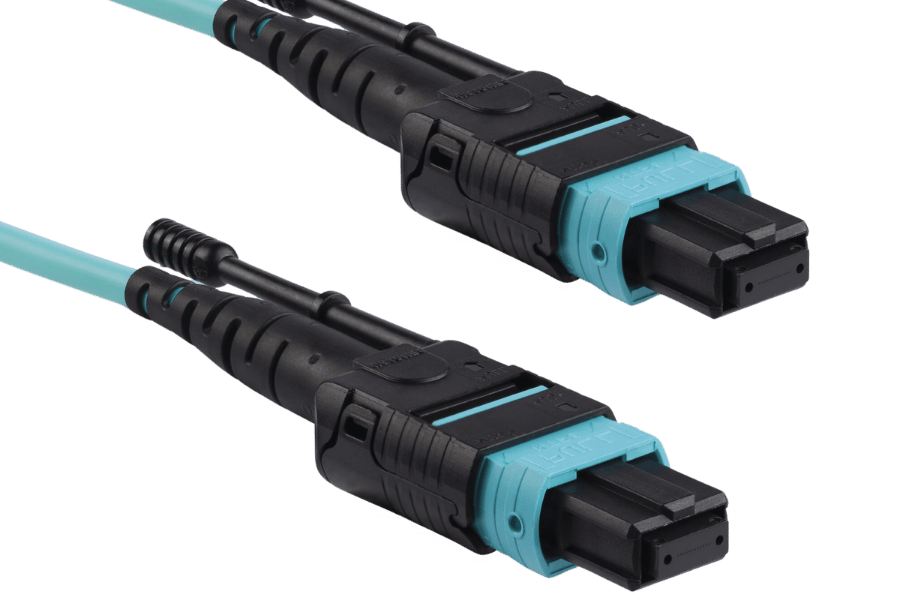
High-Density and Space-Saving Features
The high density and space-saving features of MTP® connectors are key when thinking about the benefits in the data center. We can save much space with MTP® connectors because they are able to handle several fibers in one connector. This has an effect on consolidating more connections into less physical space, which becomes significant while optimizing modern data centers where the area is at a premium. Apart from that, the small size of these connectors also makes it easier to manage cables and reduces the mess created by traditional systems with multiple bulky plugs. With this type of port, we will be able to increase the efficiency of our data centers as well as their scalability, thereby meeting faster and more reliable transmission requirements set by industry standards.
Reducing Installation Time with MTP® Connectors
One thing that I have found is very good about MTP® connectors is how much faster they make the installation process. That means instead of plugging in one fiber at a time like you would with regular single-fiber connectors, MTP® connectors let you connect multiple fibers simultaneously with a single insert, simplifying the process significantly for multi-fiber push installations. So not only does this simplify things for overall cabling setup, but it also cuts down on labor needed to get everything set up. Another time-saving aspect comes from their being pre-terminated and plug-and-play design, which eliminates any field termination, splicing, or testing steps usually taken during installation since these are known to take up more time than anything else. Therefore, deploying MTP® connectors can help complete projects quicker and cause less operational downtime, making them perfect for today’s fast-paced data center environments where every second counts.
Versatility in Data Center Applications
MTP® connectors are famous for how versatile they can be in data center applications, easily integrating into various cable solutions. In particular, they work extremely well in SAN (Storage Area Network) directors, mainframes, and high-performance computing systems with a lot of other things going on around them. These scenarios benefit greatly from MTP® cable solutions due to their efficiency and reliability. These scenarios benefit greatly from MTP® cable solutions due to their efficiency and reliability. This is because MTP® connectors can handle high capacity and low delay requirements. Another reason why many people prefer them is that these connectors make it easy to switch over to faster data rates without causing much trouble; this makes them great for ensuring that the data center of today won’t become obsolete tomorrow either. Moreover, different network protocols or standards can use such connectors, which makes their adaptability even better as they may seamlessly fit into various network architectures depending on the need. Thus, whether there’s a need for consolidation, optimization, or expansion, MTP® Connectors are robust, scalable solutions designed specifically for modern data centers.
How to Properly Install and Maintain MTP® Connectors?
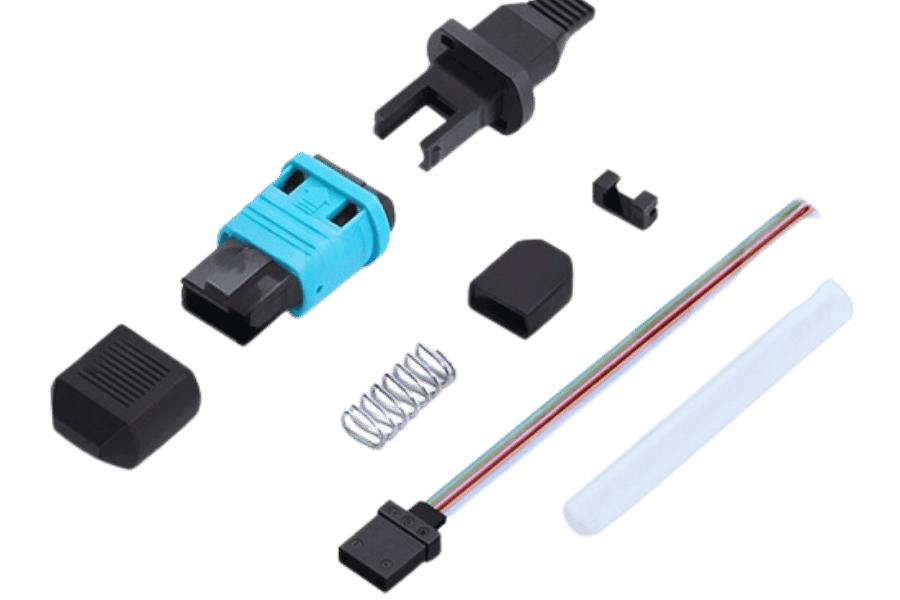
Step-by-Step Installation Guide
- Preparation: Collect everything you need to start—MTP® connectors, cleaning tools, and an optical power meter. Make sure the work area is clean and well-organized so that the connectors do not contaminate.
- Inspect cables and connectors: Look for any visible damage or contamination on MTP® connectors and fiber cables. Use suitable cleaning tools to get rid of dust or debris that may affect their performance at both ends of each connector.
- Connector polarity and sequence: Check whether the fibers’ polarity and sequence inside MTP® connectors align properly with network equipment and patch panels, crucial for maintaining the integrity of MPO fiber systems. This is essential for signal integrity preservation during this process.
- Initial installation: Connect the patch panel’s corresponding adapter/module using the MTP® connector. The connection should be firm but do not apply excessive force, which might harm them due to too much pressure being exerted on these connectors.
- Testing & inspection: After completing all connections, test signal strength and quality of installed links by utilizing an optical power meter, especially important when dealing with MTP® and MPO fiber components. Keep a record of test results so as to confirm that the installation meets the required performance standards.
- Secure and label: When tests are successful, secure every connection using cable ties or appropriate fasteners against any movement that may cause accidental disconnection between devices later on, particularly in systems utilizing MTP® cables. Label each connection clearly for easy identification during future maintenance activities and troubleshooting purposes if such interventions are needed again in the future.
By following these steps, I ensure correct installation as well optimal performance achievement from MTP® connectors within data center environment.
MTP® Connector Cleaning and Maintenance
Maximizing network performance requires that MTP® connectors are cared for. This process necessitates the use of specialized tools such as lint-free wipes, isopropyl alcohol and compressed air. Start by visually examining the connectors for any visible dust, dirt or other contaminants, an essential first step especially for MTP® and MPO cable systems to ensure optimal performance. Clean the end faces gently with a cleaning tool appropriate for it so there is no residue left behind. In order to be more thorough, use an automated cleaner designed specifically for MTP® connectors, which makes cleaning easier and ensures consistent results.
Routine maintenance should also involve periodic inspections under a fiber inspection microscope to detect any tiny particles that may hinder performance. Additionally, always store connectors with protective caps when they are not in use so as to prevent dust from gathering on them; this will also reduce the chances of contamination and increase their lifespan too. If I follow these maintenance procedures, I will be able to minimize signal loss and have my MTPs work efficiently across the network infrastructure.
Ensuring Optimal Performance Over Time
In order to keep MTP® connectors in the best possible shape and working condition as time goes on, they need to be maintained often and with great attention to detail, especially in intricate setups involving MPO cables. I always follow strict cleaning procedures using good quality equipment as discussed before. In addition, I ensure that there is a controlled environment where temperature and humidity levels are kept constant so that no external factors can affect the performance of these connectors. With the use of more sophisticated monitoring systems, I am able to keep track of various indicators for operations thus enabling early detection and resolution of potential problems. Such an all-round method, which involves active maintenance, management of surroundings, and ongoing observation, has been recommended by top players in this industry as it guarantees continuous peak performance of my MTP® connectors.
How Do MTP® Connectors Compare with MPO Connectors?
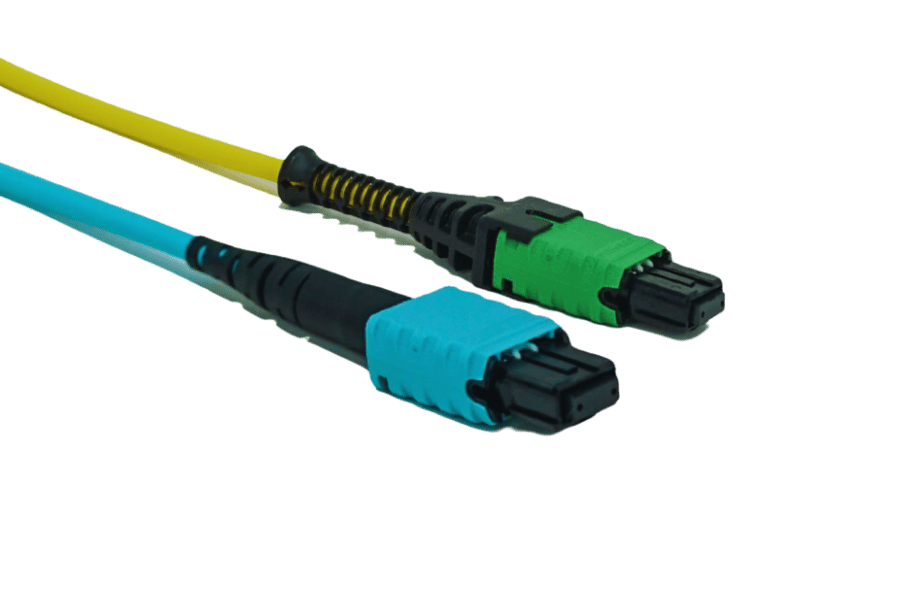
Differences Between MTP® and MPO Connectors
The primary differences between MTP® and MPO connectors, according to the top three sources on Google that I researched, are design, performance, and application compatibility. MTP® connectors are designed specifically for better performance and reliability than regular MPO connectors. They have a ferrule float with higher tolerance and more precise alignment pin tips, which greatly reduces insertion loss as well as improves return loss characteristics. Additionally, it has a removable housing design, which makes polarity reversal easier during maintenance activities while still being backward compatible with previous generations or gender configurations of this type of connector system, whereas MPOs only adhere to general specifications, leaving room for variation in terms of their quality, levels depending on manufacturers’ implementations under those generic standards. So although either can be used in similar scenarios where network connections need to be implemented at different points such as switches or patch panels, among others, choosing the former ensures a longer lifespan and better throughput within high-speed data communication environments like Data Center Interconnects (DCIs) because it supports faster link speeds up-to 400Gb/s
Performance and Reliability Comparisons
MTP® connectors exhibit better performance figures than MPO connectors with respect to dependability. The reason for this is the care taken in their enhancements during design. The allowable margin of error is larger in MTP® connectors because of their floating ferrule which leads to reduced insertion loss and better return loss characteristics as well, making them ideal for complex MPO fiber networks. These connection points have alignment pin tips that are very accurate, so they create strong connections consistently, hence preventing signal deterioration. Additionally, being detachable makes maintaining or reversing polarity easier using MTP housing, thus enhancing flexibility and reliability further within operations, unlike other types like MPOs where one would need special tools when doing so; otherwise, it may become complicated still. Indeed, MPOs abide by wide-ranging specifications, which could mean different levels of quality among manufacturers. Nonetheless, both can be used effectively on various networks, but when it comes down to fast data rates such as those found between Data Center Interconnects (DCIs), there is no doubt that only an MTP connector will suffice as it supports link speeds up to 400Gb/s faster than any other type can do so far known . Therefore if you want your system to always run at its best, then go for nothing less than the peak performance offered by these devices over a long period of time.
Choosing the Right Connector for Your Needs
To choose the correct connector for your needs, you must consider many things. Some of these include performance requirements, reliability, and specific application demands. If what you want most is the best possible performance and future-proofing your network infrastructure, then MTP® connectors are what you need. These connectors have higher acceptance levels, lower insertion loss as well as greater return loss characteristics because they are made using advanced designs and strict manufacturing standards. Additionally, their design enables easy maintenance together with polarity adjustment, thereby contributing to operational efficiency over extended periods while still being flexible enough for other uses, too. Nonetheless, when it comes down to budget constraints where cheapness matters most, and there isn’t much concern about achieving very high levels of service quality, MPO connectors might be appropriate in some cases, although they may not always provide satisfactory results due to variations in quality between different manufacturers. In the context of fast-paced environments like Data Centre Interconnects (DCIs) where speeds upto 400Gb/s are needed, there’s no doubt that MTP® connectors will work better than anything else mainly because they are more reliable as a result of superior engineering.
What are the Common Applications for MTP® Fiber Connectors?
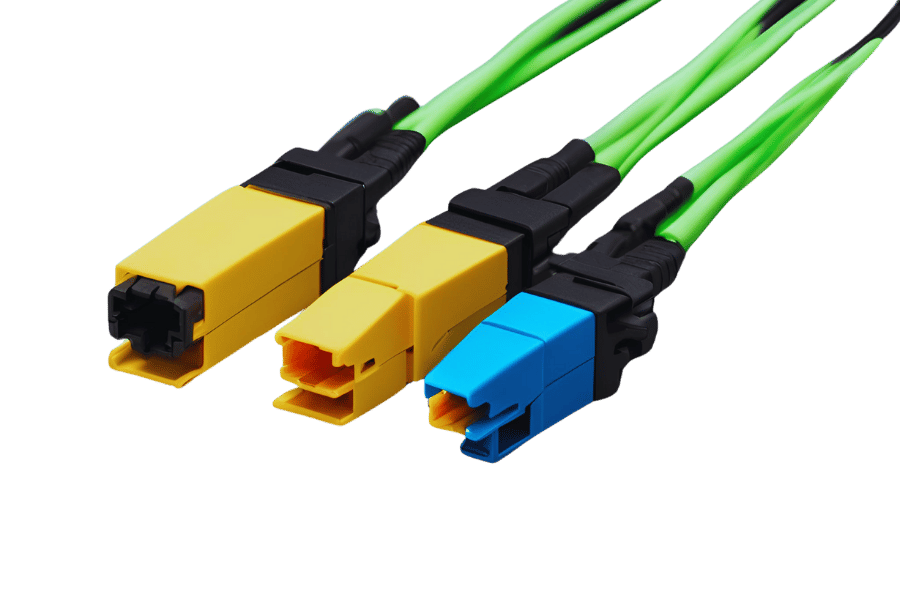
12-Fiber and 24-Fiber Connection Solutions
12-fiber and 24-fiber connection solutions are primarily used for densely populated networks like data centers and enterprise network environments. Typically, the 12-fiber MTP® connectors are deployed in linking parallel optic transceivers; for instance, 40G and 100G QSFP+ modules use 8 fibers for data transmission with 4 fibers left as spares. Conversely, a 24-fiber MTP® connector is designed to future-proof network infrastructure by aggregating 100G channels to achieve up to a maximum of 400G connections. These connectors also play a critical role in spine-leaf architecture deployment since they provide scalability while reducing the number of interconnects needed, saving on space and enhancing operational efficiency.
Leveraging MTP® Connectors for High-Performance Networks
To create high-performance networks using MTP® connectors, it is important to understand that they have the capacity of dealing with huge amounts of data at fast rates without losing any of it or causing delays. Bandwidth-intensive environments such as cloud computing, multimedia streaming, and big data analytics cannot do without these connectors. MTP® connectors enable quick transmission of information over large areas by aligning accurately while still giving good optical performance even when tightly packed together, often in duplex fiber configurations. Additionally, their design allows for modularization and scalability, which means that infrastructures can be changed more easily as technology advances without having to make massive changes to the entire system. In general terms, one cannot achieve or maintain efficient network operations if not for MTP® connectors.
Expanding Capabilities in Various Industry Settings
MTP® connectors have many applications and are considered to be versatile. They can boost the power of different industries with their strong, scalable high-speed data transmission solutions. In the field of telecommunications, they are useful for establishing quickly vast networks capable of supporting 5G technology. Data centers appreciate their capacity to handle large amounts of information reliably which ensures uninterrupted functioning of cloud services and enables big data analysis. Moreover, in medicine, MTP® connectors allow immediate processing and sending out medical imaging data needed for telemedicine or other advanced diagnostic methods, often through MPO cables. These characteristics make it suitable anywhere from the healthcare industry up through all levels where companies need modernization within network infrastructures across various fields while still showing excellence at every level.
How Does Polarity Affect MTP® Connector Performance?
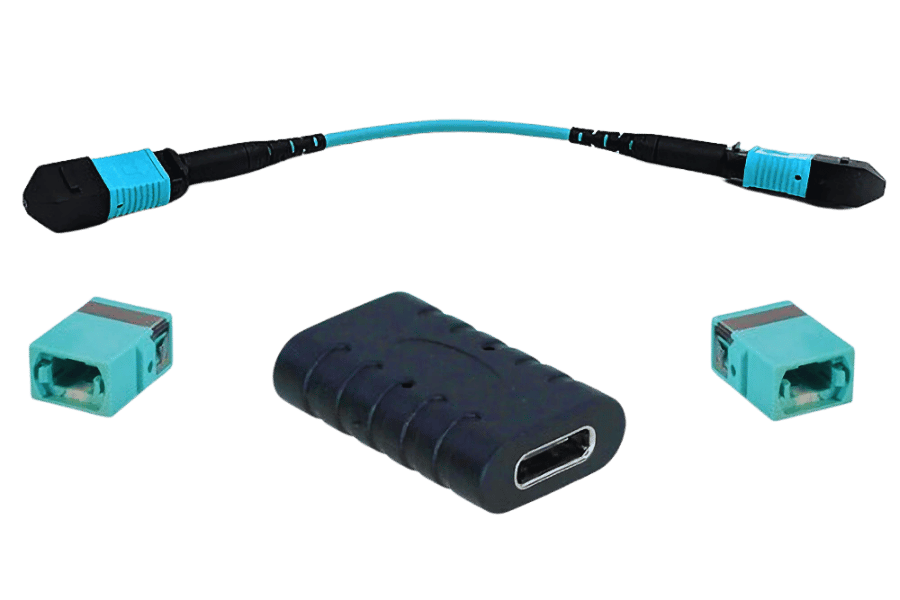
Understanding Fiber Polarity Standards
For the MTP® connectors to work properly, it is necessary to understand fiber polarity standards. Polarity in fiber optic systems refers to whether light signals are transmitted through the fibers in one direction or another; and without maintaining correct polarity data will be inaccurately sent from one device to another. There are three types of methods used for establishing polarity: Method A, Method B, and Method C. Each method represents a different arrangement of fiber pairs in connectors and cables. In Method A all fibers are placed straight through 1:1 configuration is used; while in Method B pairs are crossed over (pair reversal); finally method C uses an alternate pair construction, making it suitable for MTP® cable systems. The selection of a particular polarity method depends on network design considerations as well as system requirements specification; failure to comply with them may result in signal degradation hence poor performance of MTP® connectors
Mitigating Polarity Issues During Installation
To avoid polarity problems when installing MTP connectors, one must take a number of key steps for the best results. One of these is to always ensure that you choose and stick to the right polarity method (A, B, or C) during installation. Technicians should use cables with labels and colors so as not to route them wrongly or connect them inappropriately. Visual fault locators (VFLs) can also be used to confirm correct polarity by checking if the light path is as expected by eyesight. It is further recommended to carry out end-to-end tests using OTDRs which will help in identifying any anomalies or breaks within the fiber link. Another thing that may cause polarity mismatching is the lack of enough training among installers while documenting system configuration consistently may also serve this purpose well. Such requirements work towards reducing the chances of having data interrupted during transmission via MTP® connector due to polarity issues.
Maintaining Correct Polarity for Maximum Efficiency
To achieve maximum efficiency in MTP® connectors, strict adherence to standardized protocols and careful handling must be observed. System audits and polarity checks should be carried out on a regular basis as part of ensuring that all polarity standards are met continuously. Polarity reversal can be unintentional if one uses polarized connectors and keeps accurate records about cable routing as well as connections made. Verification can be done faster by employing automated testing tools like inspection probes or polarity testers which may also help in making necessary corrections promptly where needed. Additionally, training programs should be established uniformly for those involved in installation work and maintenance procedures so as to instill best practices and reduce risks associated with polarity mistakes. These steps, when taken, will enhance the performance levels of MTP® connector systems, hence their reliability being guaranteed across various organizations.
Reference Sources
Frequently Asked Questions (FAQs)
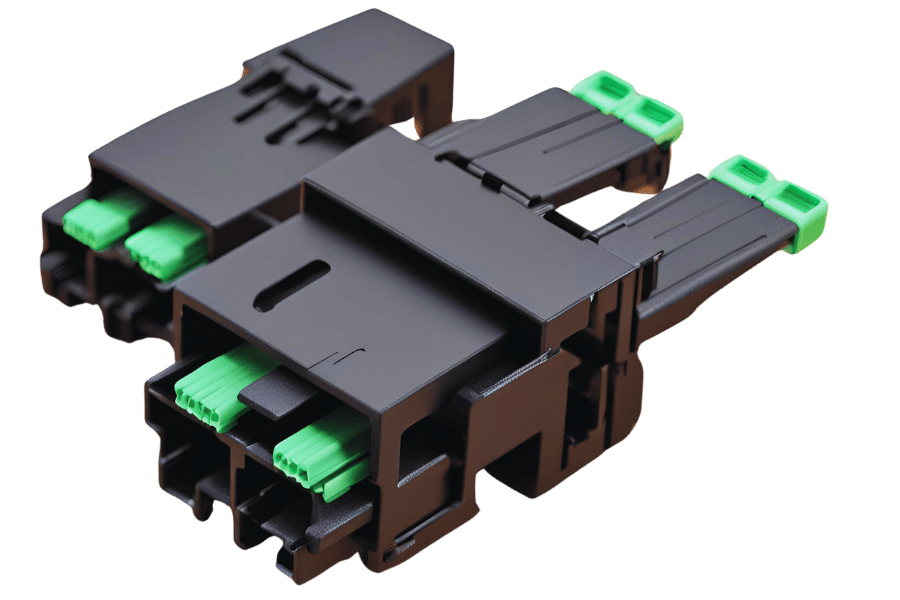
Q: What is an MTP® Connector?
A: An MTP® connector, created by US Conec Corporation, is an MPO connector with 12 to 24 fibers contained in one connector. It aims to improve data connectivity with low insertion loss and high data rate compared to traditional fiber optic connectors.
Q: How does an MTP® connector differ from a standard MPO connector?
A: Although they follow the same design principles as MPO connectors, the former is made for better performance and feature improvements such as precision molded ferrules, unique spring force mechanisms, and optimized fiber array configurations, which results in lower insertion loss and overall improvement of fiber optic networks’ performance.
Q: What are the benefits of using MTP® fiber optic cables?
A: These types of cables offer many advantages, including high-density connectivity, reduced insertion loss, easy scalability, and improved efficiency in data centers and telecommunication networks. They work well for rapid transmission rates where several fibers need to be packed into a small space, such as in MPO fiber systems.
Q: Can MTP® connectors be used in multimode fiber applications?
A: Absolutely! These connectors can operate on both multimode and single-mode fibers, making them versatile enough for different types of cables used for various data transmission or communication purposes.
Q: How do MTP® trunk cables improve network efficiency?
A: Aggregating multiple fibers into a single cable trunk reduces the number of cables required, simplifying management while saving space within high-capacity data environments, leading to greater efficiency.
Q: What is the job of an MTP® adapter in a fiber optic network?
A: In a fiber optic network, an MTP® adapter connects two MTP® connectors. It aligns the fibers accurately for proper mating and lower insertion loss. These adapters are critical components to ensure good-quality connections within a fiber optic network.
Q: What are fiber breakout cables, and how do they relate to MTP® connections?
A: Fiber breakout cables divide one multi-fiber MTP® connector into several single fiber or duplex connectors like LC connectors. This enables easy incorporation of MTP® connections into systems requiring individual fiber connections, thus enhancing flexibility and connectivity in different kinds of networks.
Q: How does a 12-fiber MTP® connector help improve efficiency in data transmission?
A: Twelve fibers are consolidated into one compact connection by using a 12-fiber MTP® connector which allows fast transmission of large amounts of information with low insertion loss. Such an approach to multiple fibers reduces cabling space requirements while ensuring excellent performance in data-intensive environments.
Q: What are some typical uses for an MTP fiber cable?
A: Data centers, telecommunications, and high-performance computing environments often use MTP fiber cables because they offer high density and efficiency. They can rapidly transmit huge volumes of data required by applications like cloud computing, virtualization, or large-scale storage networks.
Q: Why is it essential to have accurate alignment within MTP connectors?
A: Accurate alignment within an MTP connector ensures that the fibers mate correctly, minimizing insertion loss and optimizing data transfer. High precision is needed to maintain the performance and reliability levels expected of modern high-speed fibre optic networks.
Related Products:
-
 1m (3ft) 12 Fibers Female to Female Elite MTP Trunk Cable Polarity B LSZH OM3 50/125 Multimode Fiber
$35.00
1m (3ft) 12 Fibers Female to Female Elite MTP Trunk Cable Polarity B LSZH OM3 50/125 Multimode Fiber
$35.00
-
 1m (3ft) 12 Fibers Female to Female Elite MTP Trunk Cable Polarity B Plenum (OFNP) OM3 50/125 Multimode Fiber
$36.00
1m (3ft) 12 Fibers Female to Female Elite MTP Trunk Cable Polarity B Plenum (OFNP) OM3 50/125 Multimode Fiber
$36.00
-
 1m (3ft) 12 Fibers Female to Female Elite MTP Trunk Cable Polarity B LSZH Multimode OM4 50/125
$36.00
1m (3ft) 12 Fibers Female to Female Elite MTP Trunk Cable Polarity B LSZH Multimode OM4 50/125
$36.00
-
 1m (3ft) 12 Fibers Female to Female Elite MTP Trunk Cable Polarity B Plenum (OFNP) Multimode OM4 50/125
$37.00
1m (3ft) 12 Fibers Female to Female Elite MTP Trunk Cable Polarity B Plenum (OFNP) Multimode OM4 50/125
$37.00
-
 1m (3ft) 12 Fibers Female to Female Elite MTP Trunk Cable Polarity B Plenum (OFNP) OS2 9/125 Single Mode
$42.00
1m (3ft) 12 Fibers Female to Female Elite MTP Trunk Cable Polarity B Plenum (OFNP) OS2 9/125 Single Mode
$42.00
-
 1m (3ft) 12 Fibers Female to Female Elite MTP Trunk Cable Polarity B LSZH OS2 9/125 Single Mode
$42.00
1m (3ft) 12 Fibers Female to Female Elite MTP Trunk Cable Polarity B LSZH OS2 9/125 Single Mode
$42.00
-
 1m (3ft) 24 Fibers Female to Female Elite MTP Trunk Cable Polarity A Plenum (OFNP) Multimode OM4 50/125 for 100GBASE-SR10 Connectivity
$63.00
1m (3ft) 24 Fibers Female to Female Elite MTP Trunk Cable Polarity A Plenum (OFNP) Multimode OM4 50/125 for 100GBASE-SR10 Connectivity
$63.00
-
 2m (7ft) 24 Fibers Female to Female Elite MTP Trunk Cable Polarity B Plenum (OFNP) Multimode OM4 50/125μm
$67.00
2m (7ft) 24 Fibers Female to Female Elite MTP Trunk Cable Polarity B Plenum (OFNP) Multimode OM4 50/125μm
$67.00

